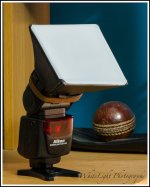WhiteLight
Senior Member
So just when i thought i'd learnt something about the SB700, i got stumped.
Please excuse my
I ordered a $2 diffuser from ebay D) & i was trying to work with it.
D) & i was trying to work with it.
Now this is my setup-
D7000 with the SB700 on camera...
In the menu, i've set the flash control as TTL
I set the flash to TTL as well.
Now the meter on the camera shows the same settings with or without the flash turned on..
So if i am in a darkish setting, the shutter speed is extra long.. which either brings in camera shake and/or the image is totally washed out.
I assumed TTL meant the camera would give the right metering settings considering the flash output.
am i totally wrong with this & i would need to just not take the metering into account and adjust the aperture/shutter speed at some setting and try trial and error?
Same with Manual mode on the flash instead of TTL?
Now if the flash were placed off camera, would everything remain the same except in the camera menu i select 'commander'?
As you would probably figure, am totally confused at this stage.....
BTW Here's a pic of the $2 diffuser.
I hope this should be good enough?

Please excuse my
I ordered a $2 diffuser from ebay
Now this is my setup-
D7000 with the SB700 on camera...
In the menu, i've set the flash control as TTL
I set the flash to TTL as well.
Now the meter on the camera shows the same settings with or without the flash turned on..
So if i am in a darkish setting, the shutter speed is extra long.. which either brings in camera shake and/or the image is totally washed out.
I assumed TTL meant the camera would give the right metering settings considering the flash output.
am i totally wrong with this & i would need to just not take the metering into account and adjust the aperture/shutter speed at some setting and try trial and error?
Same with Manual mode on the flash instead of TTL?
Now if the flash were placed off camera, would everything remain the same except in the camera menu i select 'commander'?
As you would probably figure, am totally confused at this stage.....
BTW Here's a pic of the $2 diffuser.
I hope this should be good enough?

